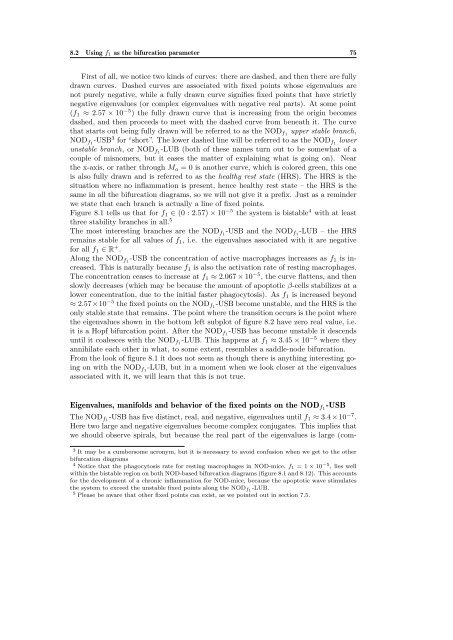nr. 477 - 2011 - Institut for Natur, Systemer og Modeller (NSM)
nr. 477 - 2011 - Institut for Natur, Systemer og Modeller (NSM)
nr. 477 - 2011 - Institut for Natur, Systemer og Modeller (NSM)
You also want an ePaper? Increase the reach of your titles
YUMPU automatically turns print PDFs into web optimized ePapers that Google loves.
8.2 Using f1 as the bifurcation parameter 75<br />
First of all, we notice two kinds of curves: there are dashed, and then there are fully<br />
drawn curves. Dashed curves are associated with fixed points whose eigenvalues are<br />
not purely negative, while a fully drawn curve signifies fixed points that have strictly<br />
negative eigenvalues (or complex eigenvalues with negative real parts). At some point<br />
(f1 ≈ 2.57 × 10−5 ) the fully drawn curve that is increasing from the origin becomes<br />
dashed, and then proceeds to meet with the dashed curve from beneath it. The curve<br />
that starts out being fully drawn will be referred to as the NODf1 upper stable branch,<br />
NODf1-USB3 <strong>for</strong> “short”. The lower dashed line will be referred to as the NODf1 lower<br />
unstable branch, or NODf1-LUB (both of these names turn out to be somewhat of a<br />
couple of misnomers, but it eases the matter of explaining what is going on). Near<br />
the x-axis, or rather through Ma = 0 is another curve, which is colored green, this one<br />
is also fully drawn and is referred to as the healthy rest state (HRS). The HRS is the<br />
situation where no inflammation is present, hence healthy rest state – the HRS is the<br />
same in all the bifurcation diagrams, so we will not give it a prefix. Just as a reminder<br />
we state that each branch is actually a line of fixed points.<br />
Figure 8.1 tells us that <strong>for</strong> f1 ∈ (0 : 2.57) × 10 −5 the system is bistable 4 with at least<br />
three stability branches in all. 5<br />
The most interesting branches are the NODf1-USB and the NODf1-LUB – the HRS<br />
remains stable <strong>for</strong> all values of f1, i.e. the eigenvalues associated with it are negative<br />
<strong>for</strong> all f1 ∈ R + .<br />
Along the NODf1-USB the concentration of active macrophages increases as f1 is increased.<br />
This is naturally because f1 is also the activation rate of resting macrophages.<br />
The concentration ceases to increase at f1 ≈ 2.067 × 10−5 , the curve flattens, and then<br />
slowly decreases (which may be because the amount of apoptotic β-cells stabilizes at a<br />
lower concentration, due to the initial faster phagocytosis). As f1 is increased beyond<br />
≈ 2.57×10−5 the fixed points on the NODf1-USB become unstable, and the HRS is the<br />
only stable state that remains. The point where the transition occurs is the point where<br />
the eigenvalues shown in the bottom left subplot of figure 8.2 have zero real value, i.e.<br />
it is a Hopf bifurcation point. After the NODf1-USB has become unstable it descends<br />
until it coalesces with the NODf1-LUB. This happens at f1 ≈ 3.45 × 10−5 where they<br />
annihilate each other in what, to some extent, resembles a saddle-node bifurcation.<br />
From the look of figure 8.1 it does not seem as though there is anything interesting going<br />
on with the NODf1-LUB, but in a moment when we look closer at the eigenvalues<br />
associated with it, we will learn that this is not true.<br />
Eigenvalues, manifolds and behavior of the fixed points on the NODf1 -USB<br />
The NODf1 -USB has five distinct, real, and negative, eigenvalues until f1 ≈ 3.4 × 10 −7 .<br />
Here two large and negative eigenvalues become complex conjugates. This implies that<br />
we should observe spirals, but because the real part of the eigenvalues is large (com-<br />
3 It may be a cumbersome acronym, but it is necessary to avoid confusion when we get to the other<br />
bifurcation diagrams<br />
4 Notice that the phagocytosis rate <strong>for</strong> resting macrophages in NOD-mice, f1 = 1 × 10−5 , lies well<br />
within the bistable region on both NOD-based bifurcation diagrams (figure 8.1 and 8.12). This accounts<br />
<strong>for</strong> the development of a chronic inflammation <strong>for</strong> NOD-mice, because the apoptotic wave stimulates<br />
the system to exceed the unstable fixed points along the NODf1 -LUB.<br />
5 Please be aware that other fixed points can exist, as we pointed out in section 7.5.
















